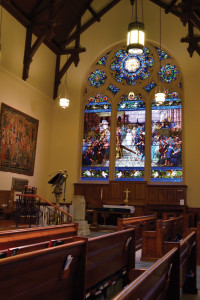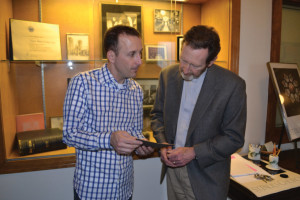Searching for Tiffany in the Midwest
EMERGING SCHOLARS > SUMMER RESEARCH GRANTS
By Josh Probert
Iowa and Wisconsin are not the states that first come to mind when one thinks of the nation’s best collections of Tiffany stained glass, yet both contain treasure troves of ecclesiastical works from the decades surrounding the turn of the twentieth century. The summer research grant from the Decorative Arts Trust allowed me to travel to Dubuque, IA, and Milwaukee, WI, to conduct research at four churches that contain some of Tiffany’s finest ecclesiastical works. Doing so helped me further one of the goals of my dissertation, “Gilded Religion in the Age of Tiffany, 1877–1932”: to demonstrate that the Tiffany Studios story extends beyond New York, Boston, and Newport, for it is indeed a national story.
Industrial power created centers of wealth far from the Tiffany showrooms on Madison Avenue. Milwaukee and Dubuque were two of these new, affluent areas. Their regional elites sought out New York’s most fashionable decorating firms to furnish their churches. Members of St. John’s Episcopal Church in Dubuque, for example, commissioned John La Farge to produce a set of lancet windows for its chancel. Other members retained Tiffany to produce five of the windows in the nave.
At the nearby First Congregational Church, the Stout family, who were lumber barons, commissioned a memorial window for family matriarch Eveline Deming Stout from Tiffany in 1895. The window depicts a female “Angel of Victory” set in a Romanesque archway and stands in stark contrast to those by regional makers in its exceptional three-dimensionality, saturation of color, and handling of the human figure.
I was familiar with Dubuque’s St. Luke’s United Methodist Church, as it contains a staggering one hundred and ten Tiffany windows. Most are pedestrian, ornamental examples, however, that appear mostly outside the sanctuary in the church’s offices and classrooms and even in the restrooms. The glassworkers at Tiffany produced thousands of windows like these that are all but impossible to identify without documentation. They provide significant evidence of the full range of goods that Tiffany produced.
In Milwaukee, I studied the windows of St. Paul’s Episcopal Church, including the famous Kemper Memorial Window (1884), a monumental depiction of Christ leaving the house of Pilate on his way to Calvary. The church interior struck me as a type of Bible picture gallery, in the same vein as the thousands of Bible galleries that booksellers were publishing at the time.
Churches like those I visited were large in scale, visually intricate, saturated in color, historically informed, and artistic. They reflected as well as generated a sense of confidence in the power of the burgeoning American republic and in God’s favor. My research in these Midwestern cities reaffirmed historical arguments that had already coalesced in my mind, but it also provided new evidence and insight. I have incorporated both into my dissertation, which I plan to turn into a book in the near future. I am grateful for the Trust’s support of my research.
SAVE THE DATE
- Special Symposium
“Classical Splendor”
The Philadelphia Museum of Art
November 4, 2016 - New York Antiques Weekend
January 20-21, 2017 - Spring Symposium
Savannah
April 21-24, 2017 - Spring Study Trip Abroad
Scotland
May 14-22, 2017 - Fall Symposium
Hartford & Western Connecticut
September 2017 - Fall Study Trip Abroad
Venice and the Veneto
October 9-16 and 22-29, 2017
By Josh Probert
Iowa and Wisconsin are not the states that first come to mind when one thinks of the nation’s best collections of Tiffany stained glass, yet both contain treasure troves of ecclesiastical works from the decades surrounding the turn of the twentieth century. The summer research grant from the Decorative Arts Trust allowed me to travel to Dubuque, IA, and Milwaukee, WI, to conduct research at four churches that contain some of Tiffany’s finest ecclesiastical works. Doing so helped me further one of the goals of my dissertation, “Gilded Religion in the Age of Tiffany, 1877–1932”: to demonstrate that the Tiffany Studios story extends beyond New York, Boston, and Newport, for it is indeed a national story.
Industrial power created centers of wealth far from the Tiffany showrooms on Madison Avenue. Milwaukee and Dubuque were two of these new, affluent areas. Their regional elites sought out New York’s most fashionable decorating firms to furnish their churches. Members of St. John’s Episcopal Church in Dubuque, for example, commissioned John La Farge to produce a set of lancet windows for its chancel. Other members retained Tiffany to produce five of the windows in the nave.
At the nearby First Congregational Church, the Stout family, who were lumber barons, commissioned a memorial window for family matriarch Eveline Deming Stout from Tiffany in 1895. The window depicts a female “Angel of Victory” set in a Romanesque archway and stands in stark contrast to those by regional makers in its exceptional three-dimensionality, saturation of color, and handling of the human figure.
I was familiar with Dubuque’s St. Luke’s United Methodist Church, as it contains a staggering one hundred and ten Tiffany windows. Most are pedestrian, ornamental examples, however, that appear mostly outside the sanctuary in the church’s offices and classrooms and even in the restrooms. The glassworkers at Tiffany produced thousands of windows like these that are all but impossible to identify without documentation. They provide significant evidence of the full range of goods that Tiffany produced.
In Milwaukee, I studied the windows of St. Paul’s Episcopal Church, including the famous Kemper Memorial Window (1884), a monumental depiction of Christ leaving the house of Pilate on his way to Calvary. The church interior struck me as a type of Bible picture gallery, in the same vein as the thousands of Bible galleries that booksellers were publishing at the time.
Churches like those I visited were large in scale, visually intricate, saturated in color, historically informed, and artistic. They reflected as well as generated a sense of confidence in the power of the burgeoning American republic and in God’s favor. My research in these Midwestern cities reaffirmed historical arguments that had already coalesced in my mind, but it also provided new evidence and insight. I have incorporated both into my dissertation, which I plan to turn into a book in the near future. I am grateful for the Trust’s support of my research.



